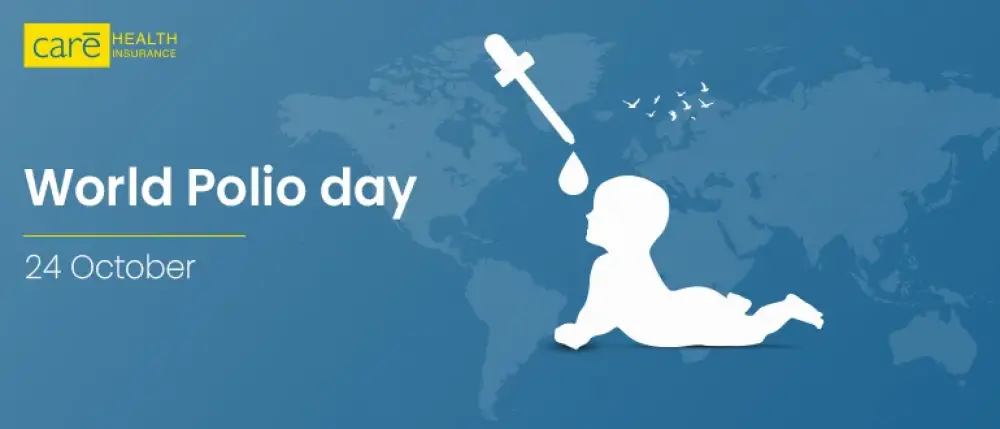Subscribe to get weekly insights
Always stay up to date with our newest articles sent direct to your inbox
Published on 23 Oct, 2024
Updated on 29 Oct, 2025
625 Views
3 min Read

Written by Pratham Gupta
Reviewed by Akhil Pillai
favorite0Like
favoriteBe the First to Like
Did you know that India was declared polio-free by the World Health Organization (WHO) in 2014? This milestone marked a major victory in global health, but the fight isn’t over yet. Polio was one of the most feared diseases of the 20th century, primarily affecting young children. At its peak in the 1980s, the disease paralyzed over 1,000 children every day worldwide.
Thanks to global immunization campaigns led by Rotary International, WHO, and other organizations, over 2.5 billion children have been vaccinated, and global polio cases have dropped by 99%.
Every year, October 24 is observed as World Polio Day to raise awareness, celebrate progress, and reinforce the urgent need to eradicate polio completely.
Polio, or poliomyelitis, is a highly contagious viral infection that primarily affects children under the age of 5. The disease is caused by the poliovirus, which enters the body through the mouth and multiplies in the intestine. In severe cases, it can attack the nervous system, leading to muscle paralysis or even death.
Poliovirus causes polio and spreads through infected individuals. The virus enters the body and reproduces in the throat and the gut, affecting nerves that control muscle movement. In severe cases, it may cause paralysis affecting the legs, arms, or the muscles that control breathing. It mainly affects children under 5. However, adults can also get a polio infection if they are not vaccinated.
Polio is a contagious disease that spreads from one person to another. The poliovirus enters the body through the mouth or nose and is transmitted through:
Close contact with infected individuals
Poliovirus, or wild poliovirus, has three variants: type 1, type 2, and type 3. However, only type 1 poliovirus is still present in some countries today, as types 2 and 3 have been eradicated. Different types of polio affect the body differently, depending on the part of the body infected by the poliovirus:
Mildest form
Flu-like symptoms: fever, fatigue, sore throat, headache, vomiting, and diarrhea
More serious, can cause meningitis-like symptoms such as:
More seriously, it can cause meningitis-like symptoms such as:
The only way to prevent polio is through vaccination and public health measures, including:
As of 2025, wild poliovirus type 1 is still present in a few countries, notably:
The disease’s persistence in conflict zones, poor sanitation conditions, and vaccine misinformation continue to pose challenges.
World Polio Day was introduced by Rotary International in the year 1985 in memory of Jonas Stalk, the lead researcher of the medical team that created the first polio vaccine in 1955. In 1988, Rotary International with the WHO launched the Global Polio Eradication Initiative (GPEI) to work towards a polio-free world.
Since then, every year the World Polio Day theme has focused on the efforts made for polio disease eradication and promoting a future filled with hope for mother and children’s health. This day is important as the fight against polio continues and World Polio Day is an occasion to
>> Read More: Know About Vaccines and The Diseases They Prevent
World Polio Day is an important day that encourages everyone to continue the fight against polio. It is the responsibility of every individual to contribute to the efforts to end Polio completely. In this initiative, Care Health Insurance extends its full support by offering comprehensive health insurance catering various medical needs of your entire family. Visit our website and secure your family!
Disclaimers: The above information is for reference purposes only. Kindly consult your general physician for verified medical advice. The health insurance benefits are subject to policy terms and conditions. Refer to your policy documents for more information.
favoriteBe the First to Like
Thyroid : मामूली नहीं हैं महिलाओं में थायराइड होना, जानें इसके लक्षण और घरेलू उपचार Vipul Tiwary in Diseases
शुगर कंट्रोल कैसे करे? जानें, डायबिटीज में क्या खाना चाहिए Vipul Tiwary in Health & Wellness
हाई ब्लड प्रेशर को तुरंत कंट्रोल कैसे करें? देखें इसके उपाय Vipul Tiwary in Diseases
पैरों में दर्द किस कमी से होता है? जानें, इसके घरेलू इलाज Vipul Tiwary in Health Insurance Articles
National Newborn Care Week: Every Touch, Everytime, Every Baby! Mudit Handa in Awareness Days
Pancreatic Cancer Awareness Month: Shine a Light for Early Detection! Mudit Handa in Awareness Days
Lung Cancer Awareness Month: Breaking Barriers to Champion the Cause Mudit Handa in Awareness Days
World Immunization Day: Attaining Physical and Financial Immunity Mudit Handa in Awareness Days
Always stay up to date with our newest articles sent direct to your inbox
Loading...